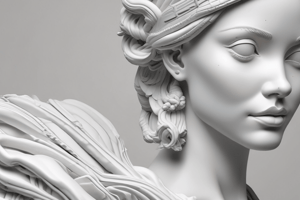Podcast
Questions and Answers
Carving is an additive process that reveals form from a hard substance.
Carving is an additive process that reveals form from a hard substance.
False (B)
Casting involves pouring a liquid material into a mold to create a solid shape.
Casting involves pouring a liquid material into a mold to create a solid shape.
True (A)
Kinetics sculpture refers to stationary sculptures that do not move.
Kinetics sculpture refers to stationary sculptures that do not move.
False (B)
A grotto is a recessed place where sculptured figures or busts can be located.
A grotto is a recessed place where sculptured figures or busts can be located.
Niches are associated with walls and primarily relate to the outer surfaces of structures.
Niches are associated with walls and primarily relate to the outer surfaces of structures.
Modelling is an ______ process, as opposed to carving.
Modelling is an ______ process, as opposed to carving.
Carving involves cutting or chipping away a shape from a mass of ______, wood, or other hard material.
Carving involves cutting or chipping away a shape from a mass of ______, wood, or other hard material.
Assembling incorporates everyday found objects into a three-dimensional ______.
Assembling incorporates everyday found objects into a three-dimensional ______.
Monolithic sculpture is massive, solid and uniform, carved from a slab of ______.
Monolithic sculpture is massive, solid and uniform, carved from a slab of ______.
Constructivism is a style or movement that combines assorted mechanical objects into abstract mobile ______.
Constructivism is a style or movement that combines assorted mechanical objects into abstract mobile ______.
Kinetics sculpture refers to sculptures in ______ motion.
Kinetics sculpture refers to sculptures in ______ motion.
Several forms of found objects are put together through a method of attachment called ______.
Several forms of found objects are put together through a method of attachment called ______.
A ______ is a recessed place in a wall where a sculptured figure or bust can be located.
A ______ is a recessed place in a wall where a sculptured figure or bust can be located.
Niches relate to the vault or convoluted inner spaces of a natural ______.
Niches relate to the vault or convoluted inner spaces of a natural ______.
Flashcards
Additive Sculpture
Additive Sculpture
A process of creating sculpture by adding materials to build up the form, rather than removing them.
Carving
Carving
Removing pieces of material to create a sculpture's shape.
Casting
Casting
Creating a sculpture from a liquid material poured into a mold.
Assemblage
Assemblage
Signup and view all the flashcards
Monolithic Sculpture
Monolithic Sculpture
Signup and view all the flashcards
Constructivism
Constructivism
Signup and view all the flashcards
Kinetics Sculpture
Kinetics Sculpture
Signup and view all the flashcards
Found Objects
Found Objects
Signup and view all the flashcards
Welding
Welding
Signup and view all the flashcards
Grotto
Grotto
Signup and view all the flashcards
Niches
Niches
Signup and view all the flashcards
Assembling Sculpture
Assembling Sculpture
Signup and view all the flashcards
Study Notes
Sculpture Techniques
- Modeling is an additive process, unlike carving, where materials are added to build up a form.
- Carving involves removing material to reveal a shape from a block of stone, wood, or other hard material.
- Casting involves pouring a liquid material into a mold to create a shape that solidifies.
- Assemblage utilizes found objects to create three-dimensional art pieces. This can create a wide range of emotional responses from the viewer.
Sculpture Types and Styles
- Monolithic sculpture is a single, solid piece of stone that is limited by the natural shape and size of the stone.
- Constructivism is a movement using combined mechanical objects to form abstract, mobile sculptures.
- Found objects (e.g., metal like wire, pipe, sheet) are combined using welding, typically in one color and texture.
- Kinetics sculpture is a form of sculpture that incorporates mechanical movement. Some kinetic sculptures produce sound when moving parts collide or interact with their surroundings.
Sculpture Location and Context
- Grotto is a recessed area in a wall that can house sculpture.
- Niches are not associated with walls, but instead relate to inner spaces of natural caves or vaults.
Studying That Suits You
Use AI to generate personalized quizzes and flashcards to suit your learning preferences.




